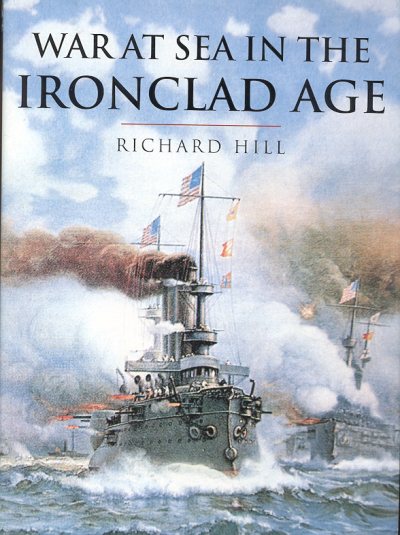|
BOOK: |
War at Sea in the
Ironclad Age |
|
BY: |
Richard Hill |
|
PUBLISHER
/PRICE: |
Cassell and Company, 2000
$29.95 |
|
REVIEW BY: |
Scott
Van Aken |
|
NOTES: |
One in a History of
Warfare series |
 OK, I'll admit it. I have a soft spot for
things naval. Having spent a number of years in and around salt water does that
to you. Though I would never admit to being a 'fleety', I do have a fascination
in things that float. It isn't as great as in things that fly, but it is enough
to see me dropping dollars in exchange for books on the subject.
OK, I'll admit it. I have a soft spot for
things naval. Having spent a number of years in and around salt water does that
to you. Though I would never admit to being a 'fleety', I do have a fascination
in things that float. It isn't as great as in things that fly, but it is enough
to see me dropping dollars in exchange for books on the subject.
Having practically no
knowledge of the early days of steam, it was with much interest that I ordered
this book (sight unseen). Not knowing what to expect, I found myself the proud
possessor of a 224 page hardback book which, it turns out, is basically a primer
on the navies of the world between 1850 and 1905. What is particularly helpful
is that the book is full of drawings, photos, diagrams and paintings so
that you can see for yourself how things developed. Those years were chosen as
they were the start of 'steam only' warships up until the launching of the
HMS Dreadnought. During this time, naval developments were under a constant
state of flux.
In no other time of ship
design and naval operations were so many changes going on at such a rapid pace.
This period saw not only a rapid evolution of nautical engineering, but also a
change in the way that naval personnel were trained and treated. It went from
basically no formal training (all of it being on the job training) to the
establishment of formal naval schooling. First with officers and later with the
ratings. One thing you have to take into account with this book is that it is
written by a Brit and looks at things from a British point of view. Actually, it
is proper that it be so as Britain was the dominant naval power at the time.
The book so pointedly states
that it is a good thing that there were no serious wars during this time
as any nations involved would have been poorly equipped to fight such a war.
Such was the flux of development. Though basically a shallow water naval war,
much was learned from the American Civil war, as that was the first real use of
ironclad ships. Riverine warfare was the norm of the time as the Union Navy
spent much of its time maintaining the blockade. There were no real fleet
actions as the world was used to at the time. Basically because the Confederate
Navy was not a real force with which to be reckoned. One thing I found
particularly interesting is that there was no rank of Admiral in the US Navy
until 1863. One of the first being David Farragut (of 'damn the torpedoes, full
speed ahead' fame). The highest rank was that of Flag Officer, and that was only
a temporary rank for a specific operation so that there would be a person in
charge.
There are numerous stories
and examples of use of these ships in small operations. The only really large
fleet actions were all extremely one sided and most of those took place in the
last ten years of the Ironclad age. Just to refresh your memories, those actions
would be Ito at the Yalu, Dewey at Manila Bay, Sampson at Santiago Bay, and Togo
at Tsushima. The first was the Sino-Japanese war of 1894, the next two were in
conjunction with the Spanish-American War of 1898, and the last the
Russo-Japanese war of 1905.
All in all, a fascinating
book, and one from which I learned a great deal. If you are interested in the
technical and sociological developments of the time, then I suggest that you
find and buy this book.
Review copy courtesy of your
editor.
If you would like your product reviewed fairly and quickly by a
site that averages over 2,000 visits a day, please contact
me or see other details in the Note to
Contributors.
 OK, I'll admit it. I have a soft spot for
things naval. Having spent a number of years in and around salt water does that
to you. Though I would never admit to being a 'fleety', I do have a fascination
in things that float. It isn't as great as in things that fly, but it is enough
to see me dropping dollars in exchange for books on the subject.
OK, I'll admit it. I have a soft spot for
things naval. Having spent a number of years in and around salt water does that
to you. Though I would never admit to being a 'fleety', I do have a fascination
in things that float. It isn't as great as in things that fly, but it is enough
to see me dropping dollars in exchange for books on the subject.